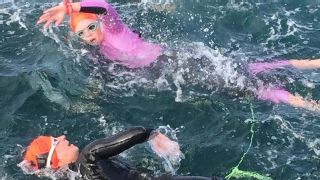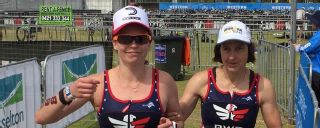|
Tina Ament was nearing the end of a long, grueling day, pushing through the marathon at the 2014 Ironman World Championship in Hawaii. Ament, a visually impaired athlete, had long dreamed of racing at Kailua-Kona, but the day wasn't going as she'd hoped. She had started with a time about 10 minutes slower than she had expected in the 2.4-mile swim because of strong currents and wind-chopped waves. Then, on the 112-mile bike ride -- on the back of a tandem bike with her sighted guide Anne Thilges -- she had to pedal into the wind for about 100 miles. The headwind they faced going out shifted late in the day, so they also had a headwind going back. "It can be so demoralizing just riding into a headwind for so long and feeling like I'm going nowhere," Ament recalls. "Like the last 30 miles on the Queen K Highway coming back through the lava fields, coming back to town, it's just like, 'Please, get me off this bike.'" To be an official finisher, Ament would have to finish in less than 17 hours. She had finished previous Ironman-distance races (140.6 miles) in 15 to 15.5 hours, so she never doubted she would complete the race in time. Yet late in the day, Ament realized she was in jeopardy. She had been walking too much. "We got to someplace around Mile 17 of the run and I was like, 'Oh no, we still have nine miles to go,'" she says. "There were some moments of panic there where we had to pick up the pace and change the strategy a little bit." As she and Thilges -- connected by a tether -- approached the end, they were energized. In the race's final hour, when athletes are striving to beat the time limit, crowds swell and get loud. Athletes who've already finished, family, friends and fans line Ali'i Drive to cheer all to the finish line. People were screaming and pounding on the barricades as the song "YMCA" blared. "A lot of people had been drinking by that point, so the crowd is raucous," Ament says, laughing. "I've never experienced anything like that finish line. It was like what everybody dreams of when you think of being a sports hero." Her time was 16 hours, 18 minutes and 5 seconds. Thilges raised Ament's arm in triumph as they crossed the line. And Ament became the first blind woman ever to complete the race. Four years later, Ament, 56, is disappointed by the time, but not what she accomplished. Thilges had told her the course at Kona can be a beast, but she had to do it to believe. "Between the wind and the heat and the lava fields, that race is really, really tough, and it takes all the fortitude that you have," she says. "No matter how good you are, it takes a lot of fortitude to get through it." Fortunately, Ament has buckets of fortitude.  Ament, 56, is an Ironman triathlete, long-distance cyclist and former college and club rower who lives in Alexandria, Virginia. A graduate of Yale and Stanford Law School, she is an assistant U.S. attorney in Washington, D.C., handling criminal appeal cases. She has accomplished all of that despite being born with Leber congenital amaurosis, a genetic disorder that her sister also has. As a girl, she had limited vision. She could do flip turns in the pool and ride horses. But over time her vision deteriorated. Now she is totally blind. Yet despite her limited vision as a kid, Ament wasn't allowed to sit around on the couch. "My parents wouldn't put up with that," she says. They told her she had to be active. She joined a swim team, but wasn't very good. In school, she had to take physical education classes like everybody else but says it was a terrible experience. She remembers the futility of being forced to play volleyball when she couldn't see the ball. "Gym class back then was kind of an ordeal for a lot of folks, especially girls," she recalls. "In co-ed gym class, you kind of got bullied by all the guys, and if you weren't like a superjock, you were made fun of. And if you were a blind not-superjock, you really got made fun of." In college she rowed for a semester, but quit when she couldn't handle the time commitment. After graduating from law school and working in private practice, however, she joined a club and rowed for 10 years. Through that sport she met people who were endurance athletes, which sparked her to try road races. She did her first marathon in 2006, and that evolved into her first triathlon in 2010 in New York City. By 2011, she'd completed her first Ironman-distance race. Endurance racing suited her better than rowing, she says, because she could set her own goals and training schedules without coordinating with a boatload of others. Since 2011, Ament has completed eight Ironman-distance triathlons, as well as numerous half-Ironman and shorter-distance tris.  In recent years she has been doing more Aquabike races (swimming-cycling duathlons) rather than triathlons, because of injuries, and ultradistance cycling races, including a 24-hour race in which she met the standard to compete in the Race Across America (RAAM). This summer, she was part of a team of vision-impaired cyclists that completed RAAM. But being a blind runner, triathlete and cyclist requires help and coordination. She loves training outside, but she needs a partner to pilot her tandem bike and a guide to accompany her on runs and triathlons. Because there isn't always someone available, she does a lot of her bike training indoors. Caroline Gaynor, a friend and guide for Ament the past eight years, calls them "logistical struggles." "She's not limited physically; it just takes way more planning when you're blind or visually impaired," says Gaynor, of Charlotte, North Carolina. "Think about it: If you want to run outside, you just go do it. Every time Tina wants to train outside, she basically needs an army of guides she can reach out to. Some people don't realize how challenging that is. So Tina does a lot of her training indoors, which I think speaks to her mental strength, just sitting on a bike in her home riding for hours and hours on end. ... I think a lot of people wouldn't choose to do that." Ament loves competing, but that's not always true of training. "I'm not going to lie, there are times when I don't [enjoy it]," she says. But, if she must do a five- or six-hour training ride indoors, she has learned to adapt, binge-watching Netflix series and reading books. She trains on average 10 to 15 hours per week ("I should do more," she says), swimming in the mornings with her triathlon club and going to the gym at her office at lunch, working around her busy work schedule. When she was training for RAAM, she did two long bike rides each week of four or more hours. Participating in RAAM had been a goal, and she was thrilled with the opportunity to be a part of Team Sea to See, a group of four blind or visually impaired athletes and four guides that alternated cycling across the United States in four- to six-hour shifts. The goal of the team -- comprised of successful professionals who also happen to be athletes -- was to raise awareness of blind unemployment and prompt companies to open their doors to visually impaired candidates. After starting in Oceanside, California, they finished in Annapolis, Maryland, on June 24, taking 7 days, 15 hours and 3 minutes. Ament says the entire experience exceeded her expectations. Though it was grueling, she loved the camaraderie, the challenge and their performance. "It was one of the most fun weeks of my life, and I never thought RAAM would be fun," she says. Gaynor, one of the four guides (also called pilots) on the team, says Ament showed her grit and fitness the whole way. At one point late in the week on a particularly hilly section of the course, Ament was asked to put in extra time on the bike when another rider was struggling, and she was terrific, says Gaynor. "She is one of the most competitive, driven people I've ever met," Gaynor says. "She has an ability to suffer that is quite remarkable. That's really served her well in the different sports she's done." Ament still has big goals. On Nov. 11, she'll do the Miami Man Aquabike national championship (1.2-mile swim, 56-mile bike), followed in February by a 24-hour cycling event. She'd love to someday go back to Hawaii to try to better her triathlon time at Kailua-Kona. She'd like to do the individual RAAM. Next year she's also hoping to do the 746-mile Paris-Brest-Paris cycling event. "I've always had it in my mind that I wanted to ride a bike in France," she says. "I guess this is one way to do that. I've got to learn the bike words in French."
|

